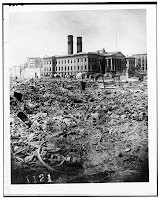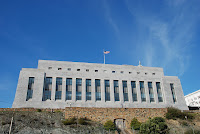The San Francisco Branch of the U.S. Mint first opened in 1857 to serve the coinage needs caused by the California Gold Rush. With the population growth in California and the demand for coins the Mint out grew the building and built a new Mint that was opened in 1874.
The new building was built beyond specification to be secure based on the known risks of the times. One worry about the new building was preventing the ability for someone to break into the building by tunneling into the basement. To prevent this, the foundation and basement were made with granite. Although the above ground structure was built using sandstone, the building earned the title “Granite Lady” following the 1906 San Francisco Earthquake when it survived with only a few exterior cracks.
The Granite Lady was the only building in its area to survive the destructive force of the quake. After the earthquake, the Mint Superintendent Frank Leach and his staff used the building and the grounds to assist with the rescue and housing effort after the earthquake. A tent city was built around the Mint and stayed until there were places for them to move.
Production continued with coins bearing the familiar “S” mintmark. Amongst the coins struck at The Granite Lady is the famous 1909-S VDB Lincoln Cent. The year after producing only 309,000 1908-S Indian Head Cents, the San Francisco Mint geared up to increase the production of the newly introduced Lincoln Cent. As the new coins landed in circulation, there was an outcry over the large “V.D.B” initials on the reverse for designer Victor David Brenner, the Mint stopped production of the coins. The Mint in San Francisco stopped after production of 484,000 of these cents, making it one of the most desired collectibles and a key date in the Lincoln Cent series.
As what happened after the San Francisco Branch Mint opened, they began to outgrow The Granite Lady. At the same time that congress authorized $524,000 to build the Bullion Repository at Fort Knox in 1935, they authorized $1.225 million to build the new San Francisco Mint.
The state of the art facility was built as a fortress with two-foot reinforced concrete walls to protect the vaults, a pistol range on the fifth floor, and tear gas pipes throughout the building for security. Also included in the construction was a generator to operate the electricity in case the power was cut to the building. When it opened, there was a plumbing shop, carpentry shop, and a blacksmith shop to support operations.
San Francisco’s new Mint opened in 1937 and became fully operational by 1938. It continued to strike circulating coins until 1955. In 1962, San Francisco was “downgraded” to an assay office. As an assay office, it struck circulating coinage starting in 1968 and ending in 1974. The San Francisco facility continued to strike proof coinage and added striking circulating Susan B. Anthony Dollars from 1979 through 1981.
Since 1981, the San Francisco Mint has struck Lincoln Cents for circulation to supplement the output of the Philadelphia Mint. It is not known how many cents San Francisco produced since their coins contained no mint mark and their inventory was included in the general reporting by the U.S. Mint without distinguishing between the facilities.
The San Francisco Assay Office was officially granted mint status again on March 31, 1988 as part of Public Law No. 100-274. That law also granted mint status to Silver Bullion Depository at West Point.
To celebrate the 75th Anniversary of the “new” San Francisco Mint, the U.S. Mint will sell a two-coin American Silver Eagle Proof set struck at the San Francisco Mint featuring the “S” mintmark. The set will include one regular proof and one reverse proof coin in a special presentation case.
In an attempt to avoid the problems of the past, the U.S. Mint will take pre-orders for the set and strike as many as collectors purchase. The U.S. Mint is likely to limit the number of sets sold during the pre-sale period, but there will be no limits on the number of sets produced.
The San Francisco Mint will begin to strike American Silver Eagle Proof coins on May 11 and will host a public ceremony on May 15. This set be on sale only during the period of June 7, 2012, to July 5, 2012 with mintage limits is being reported as “to demand.” Price has yet to be announced.
The American Silver Eagle Reverse Proof has to be one of the best looking coins produced by the U.S. Mint in the last 50 years. Aside from using the Adolf A. Weinman Walking Liberty design, which is one of my favorites, the shiny relief over the matte field really makes the design pop.
With the current American Silver Eagle Proof coin selling for $59.95, it is possible that the San Francisco set would be priced around $120. However, I think the set price may be set to $99.95 to increase sales and show some good will to collectors, especially those that were shutout of purchasing the 25th Anniversary Silver Eagle Set.
As an aside, the 100,000 unit 25th Anniversary set sold for $299.95. Recent price guides show that the set is selling is worth $825. Since the U.S. Mint plans to strike “to demand,” it is unlikely the San Francisco Anniversary set will see that kind of increase on the secondary market.
Image of the San Francisco Mint after the 1906 Earthquake courtesy of the Library of Congress.
Image of the new San Francisco Mint courtesy of Wikipedia.
Image of the San Francisco 75th Anniversary Silver Eagle Set courtesy of the U.S. Mint.





1 Comment